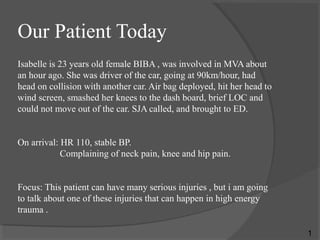
Hip dislocation
- 1. 1 Our Patient Today Isabelle is 23 years old female BIBA , was involved in MVA about an hour ago. She was driver of the car, going at 90km/hour, had head on collision with another car. Air bag deployed, hit her head to wind screen, smashed her knees to the dash board, brief LOC and could not move out of the car. SJA called, and brought to ED. On arrival: HR 110, stable BP. Complaining of neck pain, knee and hip pain. Focus: This patient can have many serious injuries , but i am going to talk about one of these injuries that can happen in high energy trauma .
- 2. Hip Dislocations By Hassan Zahoor 1
- 3. What To Cover Today Incidence Brief anatomy of Hip Joint Mechanism and types of Hip Dislocations Role Of Procedural sedation Techniques of Closed Reduction Post Reduction disposition and investigations 2
- 4. Incidence Developmental : overall frequency 1 in 1000 individuals Acquired: Highest incidence rate after hip replacement surgery. After Prim THR 3.9 percent experience Hip dislocation in first 6 months. After Revised THR surgery 15 percent experience Dislocation in 6 months. Also common in young population involved in high energy trauma. 3
- 5. Anatomy Hip is a modified ball and socket joint. Femoral head is deep in the acetabular socket – enhanced by the cartilaginous labrum. Supported by fibrous joint capsule, Ileofemoral ligament, ischiofemoral ligament, pubofemoral lig, muscles of upper thigh and gluteal region. 4
- 6. 6 5
- 7. Classification Simple vs complex Complex associated with fractures. 3 main patterns in relation to acetabulum Posterior, Anterior, Central. 6
- 8. Posterior dislocation Mostly posterior dislocation (80-90% of dislocations in MVA) Occurs with axial load on femur, typically with hip flexed and adducted. Dashboard Injury is an example of axial load on flexed hip. 7
- 9. Posterior Dislocation POSTERIOR: - flexed, internally rotated, and adducted. 8
- 10. Anterior Dislocation Femoral head situated anterior to acetabulum Hyperextension force against an abducted leg that levers head out of acetabulum. Also force against posterior femoral head or neck can produce dislocation 9
- 11. ANTERIOR: The hip is minimally flexed, externally rotated and markedly abducted 10
- 12. Central dislocation ALWAYS fracture dislocation Lateral force against an adducted femur – side impact MVA. 11
- 13. Neurovascular examination Signs of sciatic nerve injury include the following: Loss of sensation in posterior leg and foot Loss of dorsiflexion (peroneal branch) or plantar flexion (tibial branch) Loss of deep tendon reflexes at the ankle S1,2 Signs of femoral nerve injury include the following: Loss of sensation over the thigh Weakness of the quadriceps Loss of deep tendon reflexes at knee L3, 4 12
- 14. Procedural sedation Good sedation and muscle relaxation is the key Propofol alone Propofol and fentanyl Ketamine 18
- 16. 16 Whistler’s technique The patient lies supine on the gurney. Unaffected leg is flexed with an assistant stabilizing the leg. The assistant can also help stabilize the pelvis. Provider's other hand grasps the lower leg of the affected leg, usually around the ankle. The dislocated hip should be flexed to 90 degrees. The provider's forearm is the fulcrum and the affected lower leg is the lever. When pulling down on the lower leg, it flexes the knee thus pulling traction along the femur. 20
- 17. 17 21
- 18. Captain Morgan Technique 22
- 19. Stimpson Method Described primarily for acute posterior dislocations, but anterior dislocations can occasionally be reduced by this method Believed to be least traumatic Pt is in prone position w/ lower limbs hanging from end of table Assistant immobilizes the pelvis by applying pressure on the sacrum Hold knee and ankle flexed to 90 deg & apply downward pressure to leg just distal to the knee Gentle rotatory motion of the limb may assist in reduction 23
- 20. 20 24
- 21. 21 East Baltimore Technique 25
- 22. Indications Of open reduction Irreducible dislocation (approximately 10% of all dislocations) Persistent instability of the joint following reduction (eg, fracture-dislocation of the posterior acetabulum) Fracture of the femoral head or shaft Neurovascular deficits that occur after closed reduction 26
- 23. Post reduction If relocation of the hip is successful, immobilize the legs in slight abduction by using a pad between the legs to prevent adduction until skeletal traction can be instituted. ? CT scan for all traumatic dislocations after closed reduction After reduction, patients with hip dislocation should be admitted to the hospital. The duration of traction and non–weight-bearing immobilization is controversial. Evidence suggests that early weight bearing (eg, 2 wk after relocation) may increase the severity of aseptic necrosis when it occurs. 28
- 24. Complications Early: Sciatic nerve injury (posterior dislocation) Femoral-nerve injury Fractures of head and neck Femoral-artery injury (in anterior dislocations) Late: AVN of the hip incidence of AVN increases with multiple attempts. Osteoarthritis Heterotopic calcification Recurrent dislocation Ligamentous injury of the knee, other fractures Complications of immobilization (DVT, pulmonary embolus, decubiti, pneumonia) 29
